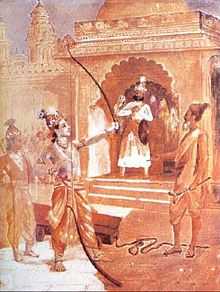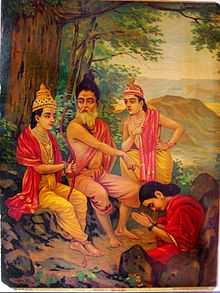Kaushik
| koushik | |
|---|---|
|
Vishvamitra (in centre) with Rama and Lakshamana, as Rama redeems Ahalya. | |
| Pronunciation | /kɔːʃɪk/ |
| Gender | Unisex |
| Language(s) | Indian languages |
| Origin | |
| Language(s) | Sanskrit |
| Word/Name | Kush |
| Meaning | Friend of the universe |
| Other names | |
| Variant(s) | Koushik, Kaushika, Koushika, Kausikasa, Kousikasa |
| Families | |
| Born in the race of king Kusika and Gadhi's son Viswamitra | |
Kaushik/Koushik is a gotra of Brahmins mainly found in India.[1] There was a Rishi (saint) by the name of "Vishvamitra" literally meaning 'friend of the universe','vishwa' as in universe and mitra as in 'friend', he was also called as Rishi 'Kaushika'.[2] Vishvamitra is famous in many legendary stories and in different works of Hindu mythology.
Kaushika/Vishvamitra Gotras
There are two gotras, or lineages, bearing the name of Visvamitra.
Kaushikasa Gotra: People belonging to Kaushika (Kaushikasa/Kaushikasa/Ghrit) Gotra take Rajarshi Kaushika as their progenitor. Kaushika was son of Vishvamitra. 11 out of 96 royal clans of Marathas belong to Kaushika gotra including the illustrious house of Shivaji. 2 more clans belong to the Vishvamitra gotra. Kaushika gotra also belongs to Baish clan of Rajputs which includes in the Suryavanshi Rajput, one of the oldest and biggest Kshatriya/Chattari clan of Vedic India. Heena Kaushika is one of the most notable descendents of the Kaushika's empire.
Kousikh/Kaushikasa is also a gotra of Brahmins of Rajasthan and Haryana. Brahmins consider themselves the descendants of the seven main sages, Angiras, Bhrugu, Vishvamitra, Kashyap, Vasishtha, Atri and Agasti.
Its origin lies in the Rig-Veda; ancient Sanskrit language. Kaushik was the son of Kushika an Indian legend.
Visvamitra Gotra: People belonging to the Visvamitra Gotra consider Brahmarishi Visvamitra as their ancestor. There is an off-shoot of "Vishvamitra Gotra" called "Chakita Vishvamitra Gotra". Two explanations have been suggested for this off-shoot. The group is supposed to have sprung from a "surprised" reaction of Vishvamitra. The other, more likely, explanation, is that a group of descendants decided to split from the main group and started their own branch of this line. A significant number of Bias Brahmins have Kaushik gotra. Some brahmins of kashmir belong to kaushika gotra.
Vishvamitra descendants still use Kaushik as their first or last name. This is how majority of the Hindu names were followed. This system of following Rishis' name as the last name was the foundation of "Gautra" in Hindu philosophy. Gautra is used to trace back ancestry especially at the time of marriages till today. Kaushik as the last name is mostly seen in Uttar Pradesh and Haryana (Northern India). for e.g. Pawan Kaushik. Kaushik is also commonly used as a first name, particularly by people in West Bengal,Tamil Nadu, Gujarat and Karnataka in India and in Bangladesh (e.g.Koushik Ghosh, Kaushik Das).
Gayatri Mantra
Brahmarshi Vishvamitra (Sanskrit विश्वामित्र viśvā-mitra "all-friend") is one of the most venerated rishi's or sages of ancient times in India. He is also credited as the author of most of Mandala 3 of the Rigveda, including the revered great Gayatri Mantra. It is a mantra cum prayer and is found in all the three Vedas; Rig, Yajur and Sama Veda. Veda's clearly state that anyone can chant this Mantra, and gain its benefits.
The Puranas mention that only 24 Rishis since antiquity have understood the whole meaning of, and thus wielded the whole power of, the Gayatri Mantra. Sage Vishvamitra is supposed to be the first, and Sage Yajnavalkya the last.
In the Ramayana

In the Indian epic Ramayana, Vishvamitra is the preceptor of Rama, prince of Ayodhya and the seventh Avatar of Vishnu, and his brother Lakshman. Shri Ram, he who is protected by Hanuman a son of the God of air (vaayou).
Vishwamitra gives them the knowledge of the Devastras or celestial weaponry (bala and adi bala), trains them in advanced religion and guides them to kill powerful demons like Tataka, Maricha and Subahu. He also leads them to the svayamvara ceremony for princess Sita, who becomes the wife of lord Rama.
References
- ↑ Singh, Kumar Suresh (1994). Daman and Diu. Mumbai, India: Popular Prakashan. p. 45.
- ↑ "Viśwamitra". mythfolklore.net.
- Masson-Oursel, P.; Morin, Louise (1976). "Indian Mythology." In New Larousse Encyclopedia of Mythology, pp. 325–359. New York: The Hamlyn Publishing Group.
- Dowson, John (2004). A classical dictionary of Hindu mythology, and religion, geography, history. Delhi: Asian Educational Services. pp. 73–5. ISBN 9788120617865.
- Ganguli, Kisari Mohan (1883–1896). "Ch.LV". The Mahabharata: Book 13: Anusasana Parva. Sacred texts archive.
